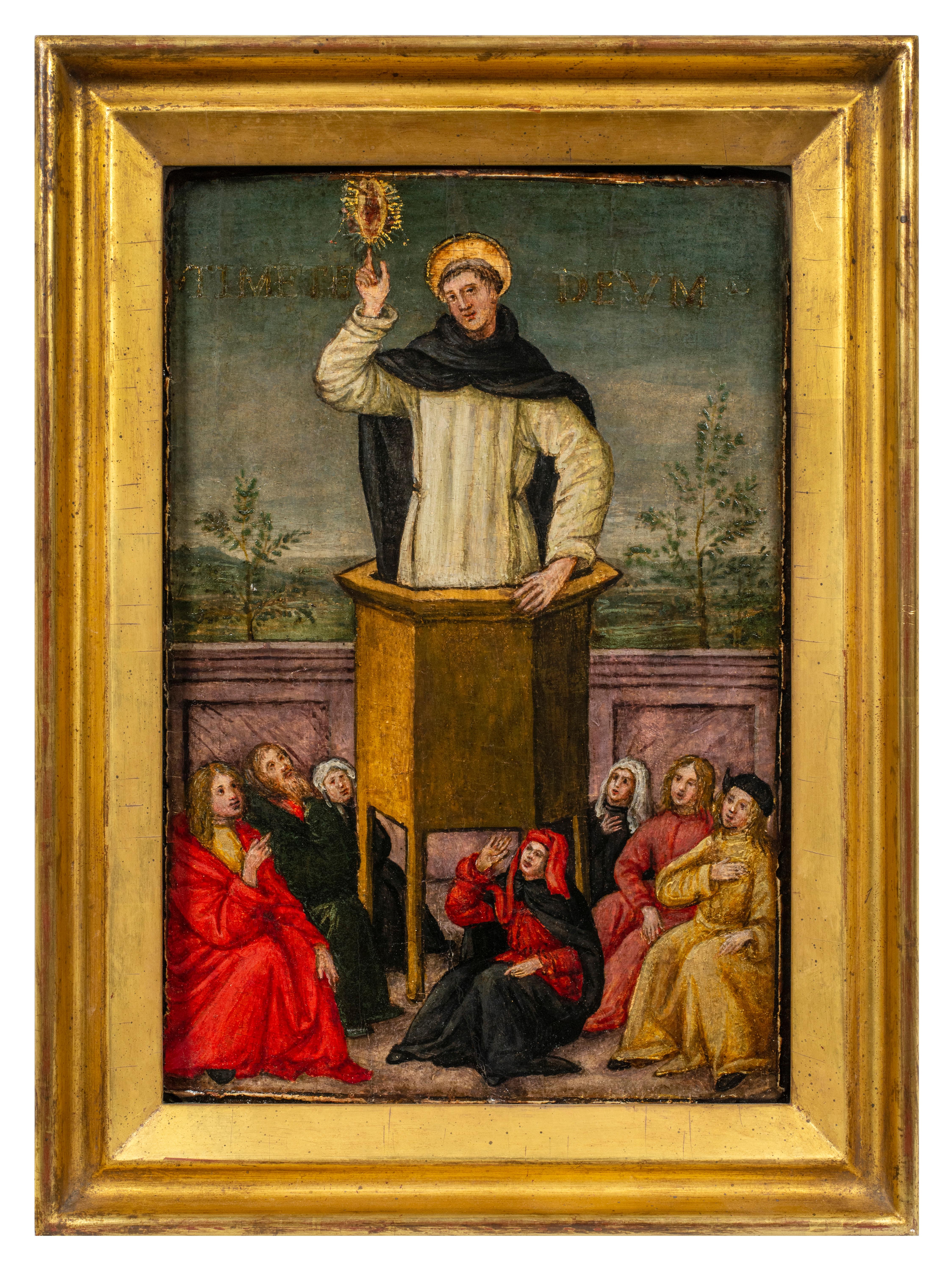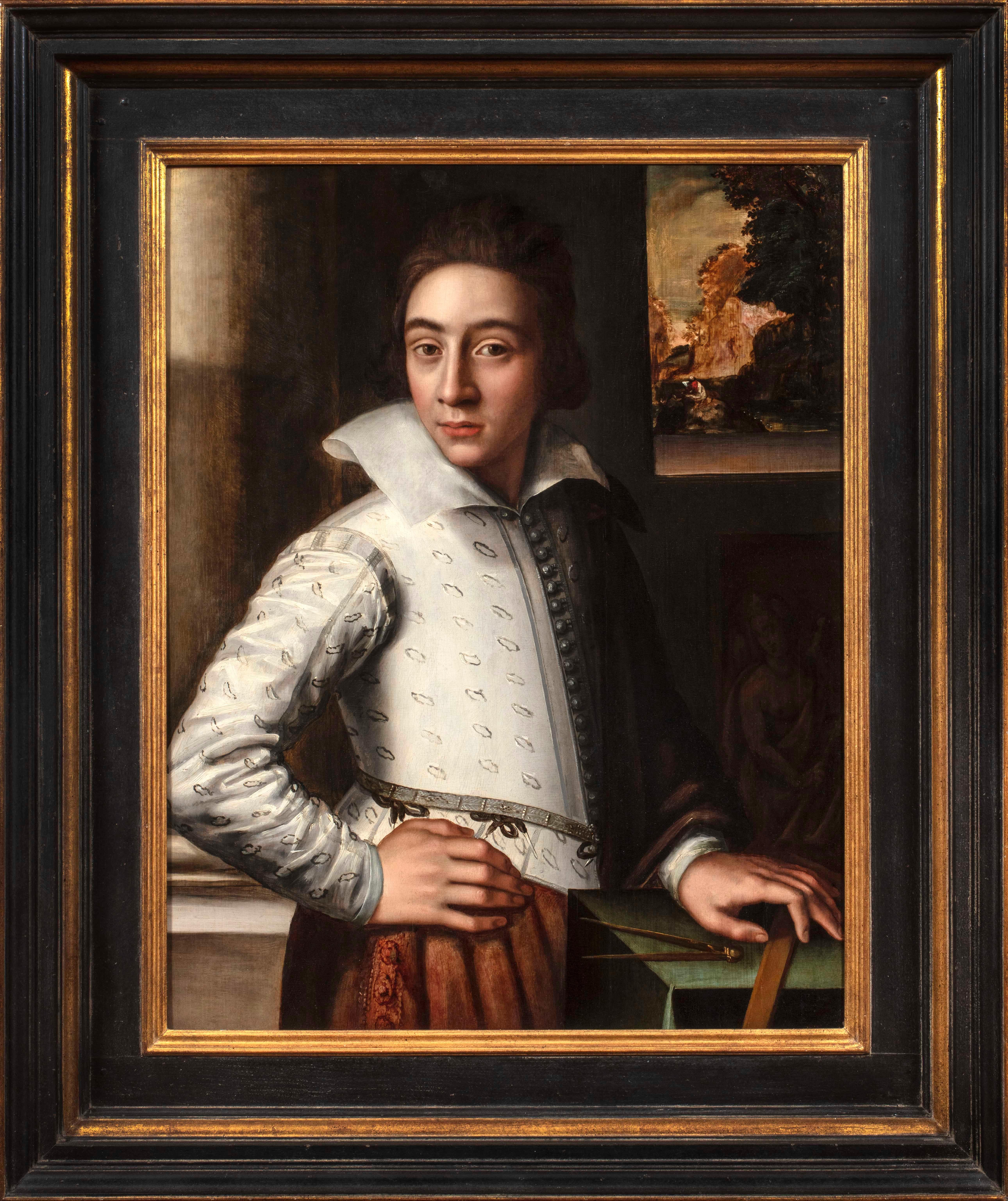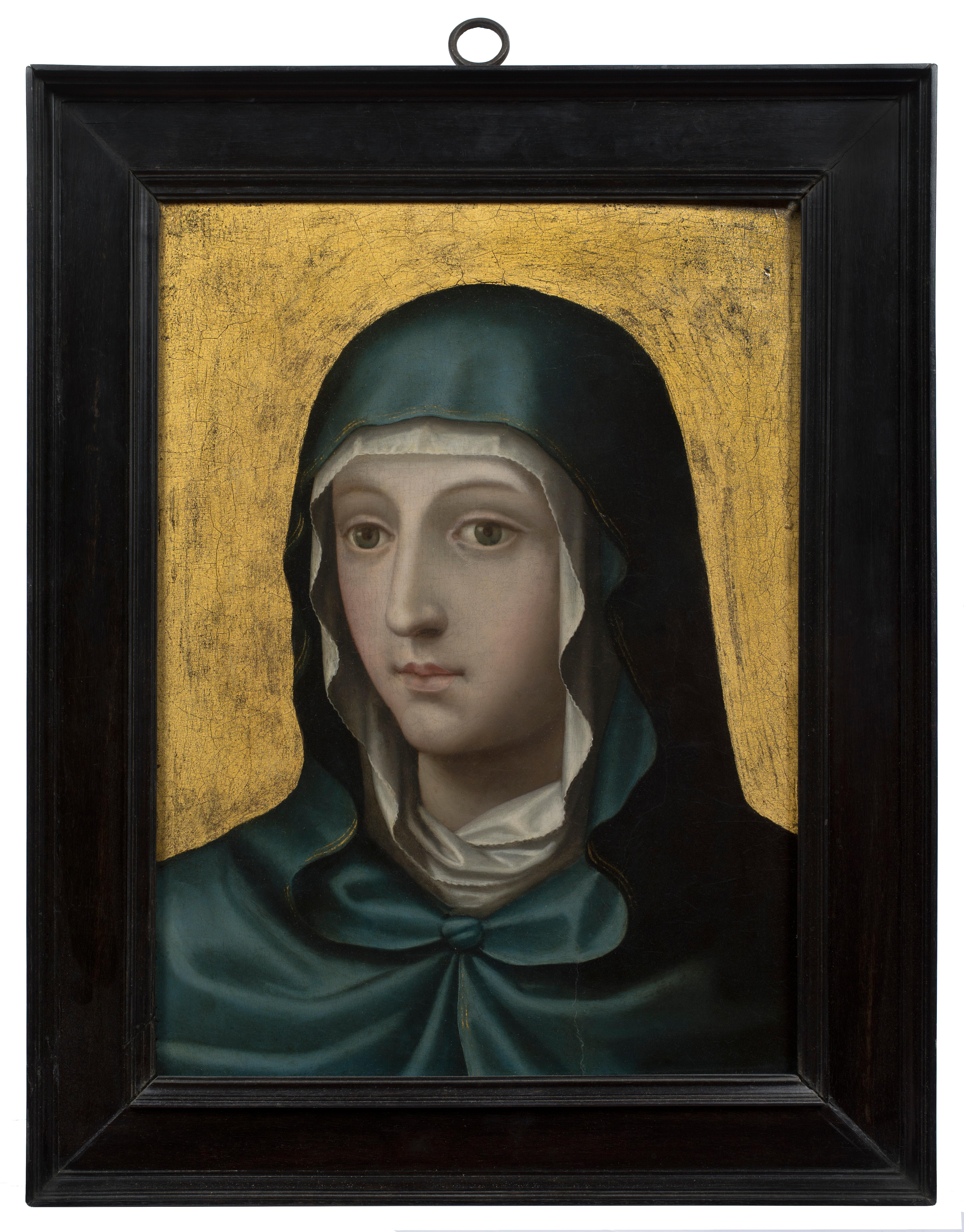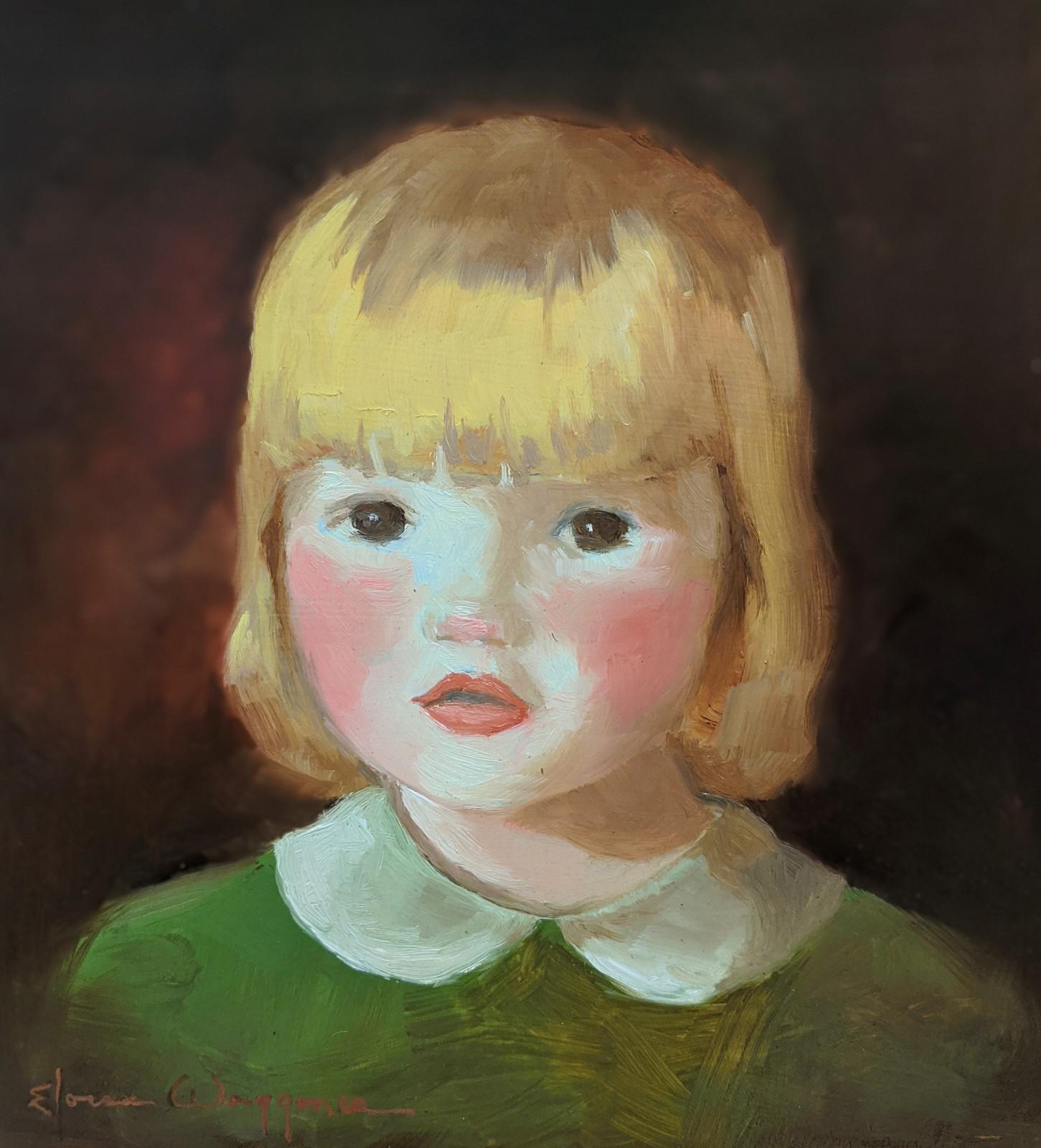Items Similar to The Gold Brooch, Orientalist Oil Painting, Signed and dated 1894
Want more images or videos?
Request additional images or videos from the seller
1 of 2
Eugene Alexis GirardetThe Gold Brooch, Orientalist Oil Painting, Signed and dated 18941894
1894
About the Item
Oil on panel, signed, dated and inscribed ‘Bou Saada, 1894’ lower right
Image size: 13 x 8 3/4 inches (33 x 22.25 cm)
Ornate Gilt frame
Euguene Alexis Girardet
A child prodigy, Girardet was already selling his paintings at seventeen. His artistic career had begun at home under the training of his father. He later went on to study at L'Ecole des Beaux-Arts under Jean-Léon Gérôme. It was Gérôme who encouraged Girardet to travel to the Orient although he had already acquired a fascination for this area from listening to his uncle’s tales.
In 1874 Girardet visited Morocco and Algeria. He made several more trips to North Africa during the 1870s, including a visit to Tunisia in 1877. However, it was Algeria that most attracted the artist; he preferred the southern towns such as El-Kantara, Biskra and Bou-Saada. It was in Bou-Saada that he met the fellow Orientalist Etienne Dinet.
He returned seven more times, not just to collect studies for his paintings, but to experience their way of life at first hand. He loved the landscape and the people, which were still free from French colonial influence.
From 1874 he exhibited in Munich, Berlin and the Paris Salons. From the mid-1880s his work was also frequently exhibited in Geneva, Zürich and London.
This stunning portrait depicts a woman from Bou-Saada, possibly an Oulud Nail dancer. The painting glows with light, it pours across her face, revealing her flesh tones and creating shadows. The stunning black headdress contrasts well with the red of her dress.
Museums
Algiers, Bâle, Geneva, Paris, Nantes, Saintes and Zurich
- Creator:Eugene Alexis Girardet (1853 - 1907, French)
- Creation Year:1894
- Dimensions:Height: 13 in (33.02 cm)Width: 6 in (15.24 cm)
- More Editions & Sizes:1 of 1Price: $35,148
- Medium:
- Period:
- Condition:
- Gallery Location:London, GB
- Reference Number:1stDibs: LU52413237652
About the Seller
5.0
Vetted Seller
These experienced sellers undergo a comprehensive evaluation by our team of in-house experts.
Established in 2007
1stDibs seller since 2014
63 sales on 1stDibs
Typical response time: 4 hours
- ShippingRetrieving quote...Ships From: London, United Kingdom
- Return PolicyA return for this item may be initiated within 14 days of delivery.
More From This SellerView All
- Portrait of a Mary Hardy (nee Sulman), Late 19th Century Victorian OilLocated in London, GBSlade School Late 19th Century Portrait of a Mary Hardy (nee Sulman) Oil on panel Image size: 8 x 7 inches Contemporary frame Provenance Lady Town (Grandda...Category
Late 19th Century Victorian Portrait Paintings
MaterialsOil, Panel
- Portrait of a Boy in a Black Tunic - Early 17th Century OilLocated in London, GBFlemish School, Early 17th Century Portrait of a Boy in a Black Tunic Oil on panel Image size: 15¾ x 13⅛ inches This accomplished portrait of an unknown boy in his early teens was p...Category
17th Century Portrait Paintings
MaterialsPanel, Oil
- Portrait of Thomas Cranmer, Archbishop of Canterbury, Mid 16th Century OilLocated in London, GBOil on panel Image size: 12 1/2 x 8 3/4 inches (31.75 x 22.25 cm) Period style hand made frame This is a portrait of Thomas Cranmer (1489 - 1556). Cranmer was the Archbishop of Canterbury in the reign of Henry VIII and launched the English Reformation. Few people have played so important a part in shaping the course of English history or had a more profound influence on England's language and literature than Thomas Cranmer. At the bottom of the painting Cranmer's name and title is inscribed. At the centre there is also Cranmer's coat of arms, the left half is the arms that all archbishops of Canterbury adopt and it has been enjoin to his own family arms...Category
16th Century Portrait Paintings
MaterialsPanel, Oil
- Portrait of a ManBy Cornelis DusartLocated in London, GBCircle of Cornelis Dusart Dutch 1660 - 1704 Portrait of a Man Oil on panel Image size: 7¾ x 5¼ inches Giltwood frame Cornelis Dusart Cornelis ...Category
17th Century Old Masters Portrait Paintings
MaterialsPanel, Oil
- Portrait of William Herbert, 3rd Earl of Pembroke, Early 17th Century PortraitLocated in London, GBEnglish School, (circa 1600) Portrait of William Herbert, 3rd Earl of Pembroke Oil on panel, oval Image size: 29¼ x 23⅞ inches Painted wooden frame Provenance: 176, Collection of Francis Greville, 1st Earl of Warwick. The Trustees of the Lord Brooks’ Settlement, (removed from Warwick Castle). Sotheby’s, London, 22nd March 1968, lot 81. Painted onto wooden panel, this portrait shows a dark haired gentleman in profile sporting an open white shirt. On top of this garments is a richly detailed black cloak, decorated with gold thread and lined with a sumptuous crimson lining. With the red silk inside it’s all very expensive and would fall under sumptuary laws – so this is a nobleman of high degree. It’s melancholic air conforms to the contemporary popularity of this very human condition, evident in fashionable poetry and music of the period. In comparison to our own modern prejudices, melancholy was associated with creativity in this period. This portrait appeared in the earliest described list of pictures of Warwick castle dating to 1762. Compiled by collector and antiquary Sir William Musgrave ‘taken from the information of Lord & Lady Warwick’ (Add. MSS, 5726 fol. 3) is described; ‘8. Earl of Essex – an original by Zuccharo – seen in profile with black hair. Holding a black robe across his breast with his right hand.’ As tempting as it is to imagine that this is a portrait of Robert Devereux, the 2nd Earl Essex, we might take this with a pinch of salt. Its identification with this romantic and fatal Elizabethan might well have been an attempt to add romance to Warwick Castle’s walls. It doesn’t correspond all that well with Essex’s portraits around 1600 after his return from Cadiz. Notably, this picture was presumably hung not too far away from the castle’s two portraits of Queen Elizabeth I. The first, and undoubtedly the best, being the exquisite coronation portrait that was sold by Lord Brooke in the late 1970s and now hangs in the National Portrait Gallery. The second, described as being ‘a copy from the original at Ld Hydes’, has yet to resurface. The portrait eventually ended up being hung in the State Bedroom of Warwick Castle. Archival documents present one other interesting candidate. The Greville family’s earliest inventory of paintings, made in 1630 at their home Brooke House in Holborn, London, describes five portraits of identified figures. All five belonged to the courtier, politician and poet Sir Fulke Greville (1554-1628), 1st Baron Brooke, and were hung in the ‘Gallerie’ of Brooke House behind yellow curtains. One of them was described as being of ‘Lord of Pembrooke’, which is likely to have been William Herbert (1580-1630), 3rd Earl of Pembroke. William was the eldest son of Greville’s best friend’s sister Mary Sidney, and was brought up in the particularly literary and poetically orientated household which his mother had supported. Notably, the 3rd Earl was one of the figures that Shakespeare’s first folio was dedicated to in 1623. The melancholic air to the portrait corresponds to William’s own pretensions as a learned and poetic figure. The richness of the robe in the painting, sporting golden thread and a spotted black fabric, is indicative of wealth beyond that of a simple poet or actor. The portrait’s dating to around the year 1600 might have coincided with William’s father death and his own rise to the Pembroke Earldom. This period of his life too was imbued with personal sadness, as an illicit affair with a Mary Fitton had resulted in a pregnancy and eventual banishment by Elizabeth I to Wilton after a short spell in Fleet Prison. His illegitimate son died shortly after being born. Despite being a close follower of the Earl of Essex, William had side-stepped supporting Devereux in the fatal uprising against the Queen and eventually regained favour at the court of the next monarch James I. His linen shirt is edged with a delicate border of lace and his black cloak is lined on the inside with sumptuous scarlet and richly decorated on the outside with gold braid and a pattern of embroidered black spots. Despite the richness of his clothes, William Herbert has been presented in a dishevelled state of semi-undress, his shirt unlaced far down his chest with the ties lying limply over his hand, indicating that he is in a state of distracted detachment. It has been suggested that the fashion for melancholy was rooted in an increase in self-consciousness and introspective reflection during the late 16th and early 17th centuries. In contemporary literature melancholy was said to be caused by a plenitude of the melancholy humor, one of the four vital humors, which were thought to regulate the functions of the body. An abundance of the melancholia humor was associated with a heightened creativity and intellectual ability and hence melancholy was linked to the notion of genius, as reflected in the work of the Oxford scholar Robert Burton, who in his work ‘The Anatomy of Melancholy’, described the Malcontent as ‘of all others [the]… most witty, [who] causeth many times divine ravishment, and a kind of enthusiamus… which stirreth them up to be excellent Philosophers, Poets and Prophets.’ (R. Burton, The Anatomy of Melancholy, London, 1621 in R. Strong, ‘Elizabethan Malady: Melancholy in Elizabethan and Jacobean Portraits’, Apollo, LXXIX, 1964). Melancholy was viewed as a highly fashionable affliction under Elizabeth I, and her successor James I, and a dejected demeanour was adopted by wealthy young men, often presenting themselves as scholars or despondent lovers, as reflected in the portraiture and literature from this period. Although the sitter in this portrait is, as yet, unidentified, it seems probable that he was a nobleman with literary or artistic ambitions, following in the same vain as such famous figures as the aristocratic poet and dramatist, Edward de Vere...Category
Early 17th Century Old Masters Portrait Paintings
MaterialsWood Panel, Oil
- Portrait of Geoffrey Chaucer, Oil on Oak Panel Portrait, 16th CenturyLocated in London, GBOil on oak panel Image size: 14 1/4 x 11 3/4 inches (36 x 30 cm) Period style frame This portrait shows Chaucer with a string of beads in one hand and a writing implement in the other. The Arms in the top left of the picture are the Arms of Chaucer, featuring a per pale argent and gules, a bend counterchanged. This painting appears to derive, like all other portraits of Chaucer, from an illustration in an early fifteenth-century manuscript, Hoccleve's De Regimine Principum. Here Hoccleve included one portrait of Chaucer, showing him with an inkhorn around his neck and holding a rosary in one hand. Since it is likely that Hoccleve had met Chaucer, many scholars believe this could be the most genuine representation of the English writer with all other depictions being seemingly based on it. In almost all portraits of Chaucer, including this one, the poet is shown wearing a pendant attached to his vest. This item is often considered to be a penner, included in the artworks as a sign of the general occupation of a writer. Whilst the pendant is generally accepted as a case for a writing instrument, possibly with equal plausibility, it has also been suggested that the item is an ampulla, a small lead vial containing water and the blood of St. Thomas Becket...Category
16th Century Portrait Paintings
MaterialsOil, Panel
You May Also Like
- St. Vincent Ferrer Preaching to the People of SalamancaLocated in New York, NYProvenance: Private Collection, New Jersey The present painting depicts Saint Vincent Ferrer preaching from a raised pulpit to a group of seven peopl...Category
15th Century and Earlier Renaissance Figurative Paintings
MaterialsOil, Wood Panel
- Portrait of a ManLocated in New York, NYProvenance: with Leo Blumenreich and Julius Böhler, Munich, 1924 Dr. Frederic Goldstein Oppenheimer (1881-1963), San Antonio, Texas; by whom given to: Abraham M. Adler, New York, un...Category
16th Century Old Masters Portrait Paintings
MaterialsOil, Panel
- Portrait of an Artist (possibly a Self-Portrait)Located in New York, NYProvenance: Bradley Collection. Private Collection, Upperville, Virginia. Literature: Katlijne van der Stighelen and Hans Vlieghe, Rubens: Portraits of Unidentified and Newly Identified Sitters painted in Antwerp, Corpus Rubenianum Ludwig Burchard, vol. 19, pt. 3, London and Turnhout, 2021, under cat. no. 189, p. 161, and fig. 75. This painting had previously been considered to be by an anonymous Tuscan painter of the sixteenth century in the orbit of Agnolo Bronzino. While the painting does in fact demonstrate a striking formal and compositional similarity to Bronzino’s portraits—compare the nearly identical pose of Bronzino’s Portrait of a Young Man in the Metropolitan Museum of Art (Fig. 1)—its style is completely foreign to Italian works of the period. That it is painted on an oak panel is further indication of its non-Italian origin. This portrait can in fact be confidently attributed to the Antwerp artist Huybrecht Beuckelaer. Huybrecht, the brother of Joachim Beuckelaer, has only recently been identified as the author of a distinct body of work formerly grouped under the name of the “Monogrammist HB.” In recent studies by Kreidl, Wolters, and Bruyn his remarkable career has been delineated: from its beginnings with Joachim in the workshop of Pieter Aertsen; to his evident travels to Italy where, it has been suggested, he came into contact with Bronzino’s paintings; to his return to Antwerp, where he seems to have assisted Anthonis Mor in painting costume in portraits; to his independent work in Antwerp (where he entered the Guild of Saint Luke in 1579); and, later to his career in England where, known as “Master Hubberd,” he was patronized by the Earl of Leicester. Our painting was recently published by Dr. Katlijne van der Stighelen and Dr. Hans Vlieghe in a volume of the Corpus Rubenianum, in which they write that the painting “has a very Italian air about it and fits convincingly within [Beuckelaer’s] oeuvre.” Stighelen and Vlieghe compare the painting with Peter Paul Ruben’s early Portrait of a Man, Possibly an Architect or Geographer in the Metropolitan Museum of Art, in which the sitter holds a compass and wears a similarly styled doublet (Fig. 2). Huybrecht both outlived and travelled further afield than his brother Joachim, who made his career primarily in Antwerp. Whereas Joachim was the main artistic inheritor of their uncle and teacher, Pieter Aertson, working in similar style and format as a specialist in large-scale genre and still-life paintings, Huybrecht clearly specialized as a painter of portraits and was greatly influenced by the foreign artists and works he encountered on his travels. His peripatetic life and his distinctly individual hand undoubtedly contributed to the fact his career and artistic output have only recently been rediscovered and reconstructed. His periods abroad seem to have overlapped with the mature phase of his brother Joachim’s career, who enrolled in the Antwerp Guild of Saint Luke much earlier than his brother, establishing himself as an independent painter in 1560. Joachim’s activity was confined to the following decade and half, and his latest work dates from the last year of his life, 1574. Our portrait was likely produced in the late 1560s, a dating supported by the dendrochronological investigation performed by Dr. Peter Klein, which established that it is painted on an oak panel with an earliest felling date of 1558 and with a fabrication date of ca. 1566. This painting presents a portrait of an artist, almost certainly Huybrecht’s self-portrait. The young sitter is confidently posed in a striking patterned white doublet with a wide collar and an abundance of buttons. He stands with his right arm akimbo, his exaggerated hands both a trademark of Huybrecht and his brother Joachim’s art, as well as a possible reference to the “hand of the artist.” The figure peers out of the painting, interacting intimately and directly with the viewer, as we witness him posed in an interior, the tools and results of his craft visible nearby. He holds a square or ruler in his left hand, while a drawing compass...Category
16th Century Old Masters Paintings
MaterialsOil, Panel
- The Veronica of the Virgin (Verónica de la Virgen)Located in New York, NYThe panel has been attributed both to Joan de Joanes and his son Vicente Macip Comes (Valencia, ca. 1555 – 1623). Provenance: Private Collection, England, by 1886 (according to stencils on the reverse) Private Collection, New Jersey, until 2010 The Veil of Veronica, often called the Sudarium, is one of the most important and well-known relics of Christ. According to legend, Veronica offered Christ her veil as he carried the cross to his crucifixion. He wiped his face with the veil, which left the cloth miraculously imprinted with his image. Depictions of Christ’s face on a veil, or simply images that focused in on Christ’s face, were treasured objects of religious devotion. The popularity of this format also inspired similar images of the face of the Virgin. The iconographic type of the present painting is known as the Veronica of the Virgin, which was especially favored in late medieval and early Renaissance Spain. Distinct from the images of the suffering Christ, the Veronica of the Virgin is based on the legend that Saint Luke painted a portrait of Mary from life. Although scholars have sometimes mistaken them for portraits of Queen Isabella I of Castile (known as Isabel la Católica) or as a depiction of Saint Maria Toribia (known as María de la Cabeza, or, Mary of the Head), paintings like this one were clearly intended as images of the Virgin in the style of Saint Luke’s lost portrait. The Veronica of the Virgin was especially popular in Valencia, and depictions of this subject produced there all stem back to one visual prototype: a Byzantine image in the city’s cathedral (Fig. 1). This early treatment of the Veronica was given to the cathedral in 1437 by Martin the Humane, King of Aragon and Valencia, who promoted religious veneration of the Veronica of the Virgin as part of the celebration of the Immaculate Conception of Mary. This devotion spread throughout Martin’s kingdom and particularly took hold in Valencia, where the Byzantine image resided. The image, which is displayed in a gold reliquary...Category
16th Century Old Masters Paintings
MaterialsOil, Wood Panel
- Young GirlLocated in Greenville, DETitled on the back, "Head of Small Girl". Painted in a impressionist style. Labeled on the back Eloise Waggoner 24 Wilmont Mews, West Chester, PA, 19380. ...Category
20th Century Impressionist Portrait Paintings
MaterialsOil, Wood Panel
- Lost in the Woods, 19th Century French Romanticism PaintingBy Pierre Jean Edmond CastanLocated in Saint Augustine, FLArtist: Edmond Pierre Jean Castan Title: Lost in the Woods Medium: Oil on Panel Year of Work: 1875 Signed: Lower Left Dimensions: Framed 18.5" x 16.5" x 3.25" Unframed 6.25" x 4.25" Edmond Castan (1817-1892) was a French artist born in Toulouse in Haute-Garrone who specialized in capturing simple moments of daily life, interior scenes of peasants and children playing games. A pupil of neoclassical painter Francois Gerard...Category
1870s Rococo Portrait Paintings
MaterialsOil, Panel





